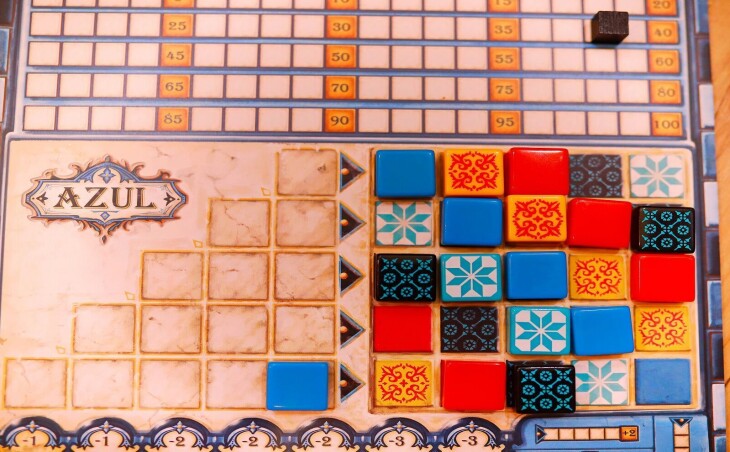The box is undoubtedly colorful and pleasing to the eye, but it does not reveal much … What does Azul hide ?
Fortunately, at the very beginning of the manual, we learn that the form of a decorative box and mosaics painted on it also contain interesting content of the game. Each player will play the role of an artist, sensitive to the surrounding space, which he is supposed to beautify … However, this is of course only an attractive envelope, because the gameplay has its irrevocable rules and in order to score as many points as possible, you need to show not so much aesthetics as … a strategy!
The whole range of colors
The creator of the game was inspired by the Portuguese form of art consisting in arranging thin ceramic tiles called Azulejo. Huge tile surfaces, often consisting of several thousand elements representing complex patterns, decorate walls and ceilings, as well as create separate decorations in churches, gardens, palaces or apartments. The division into square surfaces, both on the walls and in the game, makes the whole thing extremely orderly and legible! Perfectionists will not be able to complain about the layout of the boards and the minimalism of execution. Azul doesn’t really have many elements – a separate board for each player, pads to distribute tokens and the tokens themselves. Everything is balanced, solidly constructed, not leaving even a bit of chaos.
Colorful puzzle
Azul, as befits a Euro-game, is characterized by simple rules and a relatively short game time. We need two to four people to start the game. If you don’t know much about the flow of the game, don’t worry! Azuldefinitely does not require watching tutorials and browsing the rules for several hours. The instructions are very clear and each step is drawn and explained. In no time, we can unfold the board, draw chips on additional fields and start the queue. The task of each player is to arrange the tiles on his board in such a way that they are adjacent to the largest possible number of previously placed mosaic elements, both horizontally and vertically. The more colorful our mosaic becomes, the more difficult it is to avoid discarding some tokens, so the game becomes gradually more difficult as it progresses. After just a few minutes, I forgot about the passage of time and was completely absorbed! Interestingly, in this colorful puzzle there will also be space for negative interaction, it is not difficult to observe how to thwart your comrades’ plans. The game ends as soon as any player has completed one of the five horizontal rows of their mosaic. And what’s most exciting here is that unlike many games, it’s not the one who finishes his row first who wins. Only at the end, everyone can add up the sum of all points and evaluate the chosen tactic.
You can choose the color
Playing Azula , we will not meet with one recipe for victory. A strategy that has made us successful in one game may not work in another. Unlike many other titles from the Eurogame family, the designers did not try to eliminate the element of randomness in the game, which in this case provides a lot of great fun, allowing us to optimize our movements in various ways. It is because of the large number of variables in the form of a random distribution of tokens on the fields of the workshop or even an unexpected ending of the game by another player, we have a lot of room for creativity. These factors cause Azul is a very dynamic game, and the best way to win is to quickly adapt to the existing situation and effectively anticipate the movements of other players.

